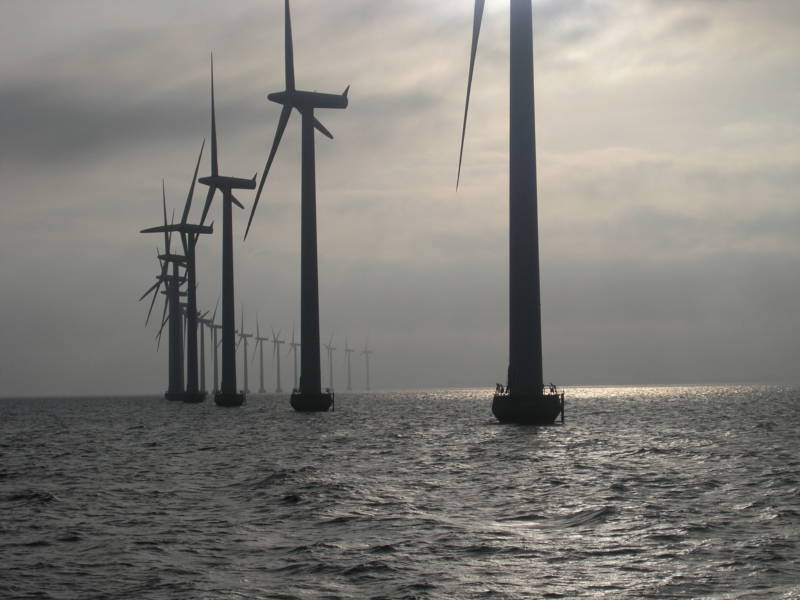
Friday on The California Report, Rob Schmitz looks at what we can learn from the world leaders in leveraging wind power.
See the photo on the left? You’re looking at three percent of Denmark’s wind power generation. This is the Middelgrunden wind farm, located in the North Sea, not far from Copenhagen. There, twenty 120-foot wind turbines produce 40 megawatts of wind energy.
I visited Middelgrunden this week in a small boat. Luckily for me, the winds, normally furious at this time of year, were moderate. I went there for a story on how Denmark was able to develop a wind power infrastructure that now produces a fifth of the country’s electric power. This is a larger proportion than any other country on Earth. For the Danes, wind power is big business.
Up until thirty years ago, Denmark was largely an agricultural country. Now, wind power-related exports are on par with agricultural exports. They make up almost 10% of the country’s total exports.
How did Denmark get to this point? The same way Japan became the most energy-efficient country on Earth: the 1970s oil shocks. In the mid ’70s, Denmark relied on oil for more than 90% of its energy. Oil embargoes brought the country to its economic knees. The government quickly instituted “Car-free Sundays,” when Danes were forbidden from driving. Shop owners were asked to turn off their lights outside of business hours. In 1979, the Denmark created its first Ministry of Energy, and it got to work on harnessing what was then considered an alternative energy: wind.
Jutting out into the treacherous North Sea, Denmark has lots of it. By 2020, Denmark plans to rely on wind for half of its electrical supply. And by 2050, the Danish government wants renewables to supply all of the country’s electricity. These are ambitious goals, but Jakob Lau Holst, COO of Denmark’s Wind Industry Association, believes it can be done.
“If you just stick to long-term government investment, you can develop a market for this,”Lau Holst told me today. He told me that much of Denmark’s industry has a hard time doing business in the US because incentives for renewables like wind “are there one year and gone the next. It’s a mixed message to the industry.” It makes one wonder what could be accomplished with more long-term goals–like California’s commitment to 33% renewables by 2020.
4 thoughts on “Nothing Ill About This Wind”
Comments are closed.

Rob, Did you visit the backup power plants that have to be ready to take over when the wind is not blowing? I understand the backup fossil fuel power plant have to be running in hot mode, ie burning fuel so they can come on line when the wind stops suddenly.
I alerted Rob to your question and he’s checking on the policy in Denmark. Here in the US, experts have told me that coordinating wind farms with base load generation is one of the trickier propositions facing the shift to renewables. Once we get past Copenhagen, I plan to air an interview I did with Dave Johnson at the National Ctr for Atmospheric Research, where they’re working on micro-forecasting models to try to better optimize wind. Right now, utilities are still faced with a guessing game in deciding when to power conventional plants up and down to augment wind energy coming onto the grid.
Question, if it provides 20% of the power what are they exporting?? “it now rivals agriculture” just wondering.
question – you are really going to depend on the weatherman to predict the wind??? PLEAAASSEE I am a fisherman, and many times if they had been within arms length I would have ripped their throats out a fed them to the fish LOL
Russ’s point is well made, that is the issue unless half of CA wants to be shutdown at the most inopertune moment. So you save nothing in reallity and spend a ton building them that will not be recovered before they fall in the ocean from corrsion.
They’re exporting the technology used in wind turbines around the world. Sorry if that wasn’t clear. The leading supplier of wind turbines is a Danish company:
http://www.vestas.com/